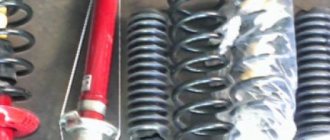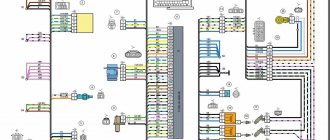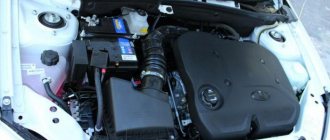Engine 11186 is the minimum power unit in terms of power. which is standard equipment on Lada Granta and Lada Kalina cars. The VAZ 11186 engine is standardly coupled with a manual transmission. The start of serial production of the engine is in 2011. Environmental standards Euro-4.
The engine is structurally designed as an in-line gasoline four with a volume of 1586 cubic centimeters. Maximum power of 87 hp. reaches at 5100 rpm. Maximum torque of 140 Nm is produced at 3800 rpm.
It is the second iteration of the modification of the classic front-wheel drive engine 21083. The predecessor is the VAZ 21114 engine with a volume of 1.6 liters. The engine has an additional index VAZ 21116. The main difference is the use of a piston system on 11186, manufactured by AvtoVAZ OJSC, and not by Federal Mogul.
The declared engine life is 200,000 km. The actual mileage before the first major overhaul is not recorded. The Russian manufacturer does not have the practice of monitoring typed cars by mileage. According to existing unverified reviews, the actual mileage exceeds the service life of 21,114, but does not reach the declared one.
SOHC engine design diagram. One camshaft located at the top of the engine. Accordingly, we have 8 valves, 2 for each cylinder. The camshaft is driven by a belt. During operation, the belt does not require replacement, since the declared life of the belt coincides with the life of the engine. The belt tension is automatic and is designed by design.
Fuel supply system is injection with electronic control. Spark plugs are standard A17DVRM. The spark is supplied by the ignition unit according to the 2-2 scheme, i.e. spark is supplied to two cylinders at the same time
Modifications applied to the engine
To ensure normal temperature conditions of 95C when using gasoline with an octane rating of at least 95, the cooling system has been modified. Changed to increase the area and flow area of the cooling channels, and increased the volume of antifreeze poured.
Changes were made to the internal channels of the engine head. To ensure increased second consumption of antifreeze, a pump from a 16-valve engine is installed on the engine. In addition, the design of the thermostat has been changed.
In order to reduce fuel consumption and increase engine reliability, major modifications have been made. The engine is equipped with a connecting rod and piston group that is lightened by almost 40% compared to the VAZ-21114 engine. This change not only reduced the weight of the engine itself, but, more importantly, reduced the inertia of the entire system. The design innovation made it possible to increase the declared service life before major repairs.
Externally, the motor also differs from its predecessor. A longer intake tract was installed, which made it possible to achieve a higher torque value and bring the performance of the 8-valve engine closer to the 16-valve engine.
The exhaust manifold has elongated pipes and a more voluminous resonator, which significantly facilitates the engine's breathing at the exhaust, since the aerodynamic resistance of the exhaust tract is reduced.
The generator mounting bracket has been changed to make it possible to adjust the drive belt using an eccentric tensioner roller. This design is also used on VAZ Vesta car engines.
What's the result?
As you can see, with the modernized 8-valve engine of the Lada Granta, not only fuel consumption has been reduced, but also dynamic performance has increased, since there is a reduction in mechanical losses. Also a plus was the reduction of vibrations and noise, and increased comfort.
We also recommend reading an article about what features, as well as advantages and disadvantages, of the Lada X-Ray engine. From this article you will learn what engine is installed on the Lada X-Ray, as well as what pros and cons this power unit has.
Finally, we note that even taking into account the lighter weight of the CPG parts, with proper and regular maintenance, we can talk about increasing the reliability of the unit, since improvements have increased its service life to 200 thousand kilometers. As practice shows, this is a very good indicator for VAZ engines.
Maintenance frequency and cost
The regulated maintenance interval is 15,000 km or 1 year, whichever comes first. The calendar maintenance period is set based on the criteria for maintaining the lubricating properties of the engine oil, taking into account its possible oxidation. The air supply system filter element is changed every 30,000 km, as are the spark plugs.
The first valve adjustment is performed after running in the engine during TO-0, then at 15,000 km during TO-1 and then at 30,000 km intervals. At TO-5 (75,000 km), the oxygen sensor is changed, and the generator drive belt is changed at 90,000 km.
The average cost of maintenance, taking into account checking other vehicle systems without the cost of consumables, does not exceed 5,000 rubles.
Technical characteristics of the VAZ 11186 1.6 8kl engine
| Type | in-line |
| Number of cylinders | 4 |
| Number of valves | 8 |
| Exact volume | 1596 cm³ |
| Cylinder diameter | 82 mm |
| Piston stroke | 75.6 mm |
| Supply system | injector |
| Power | 87 hp |
| Torque | 140 Nm |
| Compression ratio | 10.3 – 10.5 |
| Fuel type | AI-92 |
| Environmental standards | EURO 4 |
Basic faults
Structurally, it is possible to bend the valves when the timing belt breaks. Using only the original belt avoids this problem. The problem can arise due to poor assembly, which is rare, or when the belt tension system fails. In the event of an emergency, the camshaft and even the crankshaft may be bent.
After performing repairs without replacing the main and connecting rod bearings, the pressure in the oil system may drop and oil consumption may increase. It is not possible to determine whether the valve bends when the belt actually breaks under operating conditions, since there is no open manufacturer data on such a malfunction.
Replacing the timing belt is not regulated by maintenance programs.
Troubleshooting, misfire. Failure of the ignition unit. The malfunction occurs due to a defect in the block itself. The unit cannot be repaired and must be replaced entirely.
Overheat. Associated with contamination of the surface of the cooling radiator. Another reason is a malfunction of the thermostat element, which may become stuck in the open or closed position. The most common problem is that the thermostat element is stuck in the open position, which results in a lower operating temperature of the engine.
Valve knocking. This is normal wear and tear. Eliminated by selecting adjusting washers.
The engine stalls at idle or while driving. There is a problem with the electronic sensors that the motor is equipped with. Basically, the problem is solved by replacing the mass fuel flow sensor (MAF)
Idle speed fluctuates. The reason is a problem with the idle speed sensor or due to the presence of air leaks into the vacuum brake booster (it is necessary to check the pipelines for damage).
High idle speed. This malfunction indicates a break in the crankcase gas suction pipeline.
Why Granta 8-valve valve bending
The valves do not bend on all Grants. In the “Standard” modification, another unit is installed - 11183 or a transitional version 11183-50. It is less powerful, noisier and more gluttonous, but it does not bend the valves. But “Norma” and “Lux” are equipped with 11186, which requires special attention.
To achieve the best technical performance, AvtoVAZ engineers lightened the connecting rod and piston group (CPG) of the engine by 39%. But the updated ShPG did not include counterbores in the piston heads. The “oversight” led to the fact that if the timing belt on the 11186 engine is damaged, the valves bend in 99% of cases. Here's how it happens:
- The timing drive has broken.
- The camshaft has stopped.
- The valves remained open.
- The crankshaft rotates by inertia from the flywheel.
- The pistons push back and hit the valves.
- The impact bends the valve stems.
Similar article Check engine light on Lada Kalina
VAZ tried to fix the problem that caused the valve stems to bend. Federal Motors, the SHPG supplier, learned to produce pistons with recesses on the bottom, which finally helped get rid of the critical flaw. Grants with a non-plug motor went on sale from August 15, 2021.
The modified design of the pistons includes recesses for the full stroke of the valves, so the possibility of collision of parts, which causes valve bending, is excluded. In addition, the piston skirts have become more wear-resistant due to a new coating and geometry. The modifications helped reduce noise and improve gas economy.
Why does the belt break?
The valve bends when the timing drive breaks, so it is important to monitor its condition. On 11186 AvtoVAZ installs Gates belts art. 5670XS with automatic tensioner art. T43228. According to the manufacturer, the service life of the consumable is equal to the engine service life - 200,000 km. In reality, the belt runs about 50,000 km. Experts recommend checking the part during each maintenance, after 15,000 km.
In addition to the quality of the belt, how it is tensioned is also important. In engine model 11186, when backlash or jamming occurs in the pump or tension roller, the belt cuts off the teeth and the pistons bend the valve. It cuts teeth instantly, so it is rarely possible to avoid breakage.
Quality of spare parts
Gates has been cooperating with AvtoVAZ since 2003. The company's products are not cheap. A set of timing belt and tension pulley will cost at least 3,000 rubles. Is it worth saving and buying a cheap Chinese equivalent if there is a danger that if the drive breaks, the engine bends the valve?
However, even if you want to buy an original product, you can run into a fake. Under the name Gates there are counterfeits made from cheap material at a dubious price. You need to buy spare parts from official distributors. Addresses can be found on the company website.
The original timing belt is made of hydrogenated heat-resistant rubber with high resistance to various chemicals. The part has a rounded toothed profile. There are 113 teeth, 17 mm wide. Length - 1.076 m.
Similar article Design and resource of 8 and 16 valve Lada Granta engines
Belt wear is determined by the quality of the material, the presence of cracks and delaminations. The surface of the part should be elastic, not too hard. It is not permissible to stretch or shift the belt relative to the required position, otherwise it will fly off and a situation will occur in which the valve bends.
Incorrect belt installation
On a Grant with engine 11186, the valves bend in case of any damage to the timing drive. Since the slightest loosening of the belt causes teeth to be cut off, the drive must be installed strictly according to the diagram, using a special key.
If you look at the drive tension, then on the right side from the camshaft to the crankshaft you get a long arm in a free state. The force is from 15 to 20 Nm. Next, the belt covers the crankshaft sprocket. It rises to the water pump, going around the gear on the left. It goes to the tension roller on the right and returns to the camshaft.
AvtoVAZ does not recommend tensioning the drive belt yourself. According to the manufacturer, for the service you need to contact specialized services, where the part will be installed in accordance with the requirements of the plant. This is especially important if there is warranty service.
Repair
The first and main question asked by car enthusiasts and engine owners is whether the valves in the cylinder head bend? There are no design differences from other power units produced by AvtoVAZ, and therefore, of course, the valves will bend if the timing belt breaks. Therefore, the part must be replaced on time, after 45-50 thousand kilometers.
Another problem that occurs as often as bent valves is crumbling rollers. Also, a pump wedge is often encountered; in this case, bending the valve is not difficult, but the cylinder head may have additional internal faults and deformations.
Do the valves on Kalina 2 bend?
This model, Lada Kalina 2, is equipped with more than one type of engine. If you have a car in the configuration called “norm”, an improved engine with eight valves and a light group of pistons, according to another OPG, is installed under the hood (the same engines are installed on the Lada Granta). This is where the problem of pistons colliding with valves arises when the timing belt breaks. This happens due to the fact that in engines of this type the pistons have special recesses, and if the connecting rod and piston group (abbreviated ShPG) is lightened, the pistons become thin and there is simply nowhere to make recesses.
The luxury version also has a similar problem. Although there, the engines have twice as many valves - sixteen, but if the timing belt breaks, then the valves and pistons in this car also collide. Usually in luxury models this happens much less often than in others, but it still happens. The main reason that the belt breaks is the jamming of the pump, as well as the tension and support rollers.











